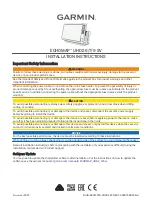
M7 GX Technical Manual
59
Raveon Technologies Corp.
VCO Bias : nnn
(the DAC value that biases the VCO in the radio. 0-1024 = 0-3.3V)
Config : hhhh
(hexadecimal representation of an internal configuration word.)
OK
11.7.
ATST3 Command
The ATST3 command, will return the time and date the firmware in the
RV-M7
was compiled.
11.8.
ATST4 Command
The ATST4 command will return internal timers that tell how long the modem has been powered up
and running. All of these timers restart a 0 upon power up.
Run time:
Years: nnn
(number of years running)
Days : nnn
(number of days running, resets to 0 after one year)
Hours: nnn
(number of hours running, resets to 0 after 23 hours, 59 minutes, 59 seconds)
Min: nnn
(number of minutes running, resets to 0 after 59 minutes, 59 seconds)
Sec: nnn
(number of seconds running, resets to 0 after 59 seconds)
Uptime:nnn
(number of seconds running. Does not reset.
OK
12. Antenna Information
Key to a successful installation is the choice and installation of a good antenna
system. A good quality antenna can more than double the range of a radio system.
Properly locating the antenna is vital to creating a quality radio link, and a poor
installation can decrease the range of the system by as much at 90%.
Use these guidelines to evaluate your antenna system design, and be sure contact
a quality radio communication equipment distributor such as
Talley Electronics
(http://www.talleycom.com ) to help choose the proper antenna for your system.
To increase your communications range, located the antenna high as needed,
practical, safe, and allowed by your license. On fixed base-station applications,
you may utilize an antenna with gain.
Note: The maximum Permissible Exposure
(MPE) for this product was computed using a 0dB gain antenna, and must be
recalculated if a gain antenna is used.
Height
Try to locate the antenna as high above obstructions, vehicle, and buildings as
possible. UHF radio channels require a clear “line-of-sight” between the transmitter
and the receiver. Radio waves will penetrate buildings, and reflect off and around
obstacles, but the fewer obstacles between stations the better the signal quality.
Gain
Antennas are specified by their gain. They actually do not have gain, but rather
they can increase the strength of a signal in certain directions, at the expense of
attenuating signals from other directions. Gain antennas always have “patterns” of
gain. It is important you understand the pattern of your antenna. Omni directional
antennas will receive from almost any angle, 360 degrees around them.












































